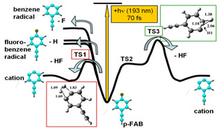Schematic illustration of the photon-induced photolysis dynamics in p-fluorophenylacetylene molecules. Presumably, the dissociation can happen via various transition states (TS) into several different reaction channels whose relative contributions are still unclear. The time-constants and structures of the proposed intermediates have also not been determined so far and are subject of our studies.
The successes of the world’s first VUV and X-Ray Free-Electron Lasers FLASH at DESY in Hamburg, LCLS at SLAC in Stanford, SACLA in Japan, and FERMI in Trieste together with the continuing technical advances in the creation of (sub-) femtosecond VUV pulses by high harmonic generation (HHG) have turned the once lofty vision of “recording a molecular movie” with femtosecond temporal and atomic scale structural resolution into a realistic scenario.
Combining the unprecedented X-ray intensities and short pulses available at Free-Electron Laser facilities with the pump-probe techniques developed with conventional laboratory-based femtosecond laser systems, research in the Ultrafast Molecular Imaging Group focuses on establishing and further developing the experimental techniques capable of imaging photochemical reactions in gas-phase molecules with atomic spatial and femtosecond temporal resolution in order to study exemplary reactions of chemical relevance with the goal of clarifying their pathways.






